Here’s How SMODE Powered Cercle Odyssey’s One-of-a-Kind Immersive Concert Series

Spanning Mexico City, Los Angeles and Paris, and creating 30 individually unique concerts, Cercle Odyssey marked a turning point in live AV production. Combining live music with real-time visuals, spatial audio, synchronicity and narrative, the project demanded an unprecedented level of integration between performance, technology and environment. At the center of the live, multisensory experience was SMODE, powering generative visuals, compositing and playback in real-time across massive projection surfaces.
The brainchild of French music platform Cercle, Odyssey was conceived as a new type of “nomadic” concert — monumental in scale yet intimate in execution. Audience members entered a 2,300-square-meter structure surrounded by 50-meter-wide and 12-meter-high screens on all sides, with the artist placed at the center. Every aspect of the show was designed to immerse the audience, from multi-layered audio and cinematographic visuals to the diffusion of specific scents.
“This is a new type of immersive and nomadic concert experience,” said Mathieu Glissant, Cercle Odyssey’s visual creator. “We travelled the world with a monumental installation — a mobile immersion space with giant screens, a central stage, spatialised sound, synchronised scents… everything is designed to offer a completely new multisensory experience. The aim was to reinvent the way people experience music at concerts.”
SMODE was chosen as the media server and real-time visual engine for the project, provided by Alabama Média, part of Groupe Novelty, using its proprietary X-REAL media server bays. A total of eight servers (including four spares) handling 12x4K feeds, each equipped with SMODE licenses, powered the demanding multi-screen projection setup. Video signals were transmitted via HDMI over optical fiber, with Lightware distribution systems ensuring low-latency delivery to the projectors.
Unlike traditional concert visuals, Cercle Odyssey was fully real-time. Visual content was not pre-rendered; it was created, adapted and synchronized live, making each concert a unique, one-time event. SMODE enabled operators to control and modify media directly during the show, tailoring content to each artist’s performance. Original content was supervised by Cercle and created in collaboration with Paris-based creative studio Motion Palace and director Neels Castillon.
Artists including Ben Böhmer, Rawayana, Max Richter, Monolink and Moby performed with visuals tailored to their styles. Shared media libraries often served as starting points, but SMODE’s compositing workflow allowed content to be reinterpreted and rearranged for each concert.
The software offered two playback modes: timecode-synchronized for precision-triggered sequences and interactive live mode for improvisational control. This gave operators flexibility to respond dynamically, adjusting parameters such as color, speed, intensity and orientation in real time. Many visuals were fully generative, with effects such as particle clouds or nebulae continuously evolving in sync with the music.
SMODE operator Morgan Davodet controlled shows live, sometimes using consoles and other times gesture-based tools such as a theremin. The setup maintained smooth performance even at ultra-high 8K resolution across five synchronized projection surfaces.
SMODE’s 3D preview function was critical during preproduction, allowing the team to visualize each concert environment before construction. This helped refine transitions, camera angles and spatial layouts, reducing on-site setup time.
“Each concert is different, and each artist has their own specific needs. SMODE allows us to adapt visual content to each performance without having to start from scratch,” Davodet said. “It allows us to reconfigure, reinterpret and reorganize media libraries according to the artistic requirements.”
The preproduction phase also included work at Groupe Novelty’s immersive studios, where teams could simulate full projection environments with spatial audio. Alabama Média provided video infrastructure and SMODE-powered servers, while Groupe Novelty designed the immersive audio system. Project manager Julien Pagnier led the audio design, coordinating technical direction, sound design and object-based mixing.
“The real challenge was to deliver an immersive mix that was both fast and efficient, while preserving the codes of a traditional concert setup,” Pagnier said. “The immersive concert concept truly shifted the live experience into another dimension.”
Odyssey’s complexity demanded absolute stability and performance under pressure. SMODE’s real-time architecture made it possible to adjust content during live shows without sacrificing fidelity. Teams could rotate virtual cameras, apply generative treatments or refine parameters to match a performance’s evolving tone, ensuring each audience experienced a truly unique concert.
The project was deployed by Dushow, a Groupe Novelty company, in Paris, with immersive front-of-house setups and an L-Acoustics system for spatial audio mixing. The integration of SMODE visuals with Odyssey’s audio, managed with Spat Revolution and MiRA (FLUX::), created a tightly coordinated AV environment where audiences were immersed both visually and sonically.


